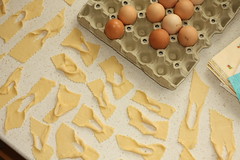 Shortly my first book on New Zealand’s cuisine will be
published so I start a series of articles on New Zealand food in general and on
that found in Poland in particular. The book will be in Polish so enjoy the
Polish introduction to the topic.
Shortly my first book on New Zealand’s cuisine will be
published so I start a series of articles on New Zealand food in general and on
that found in Poland in particular. The book will be in Polish so enjoy the
Polish introduction to the topic.
Jako że wkrótce ukaże się moja książka poświęcona kuchni
nowozelandzkiej, zaczynamy cykl postów przybliżający kiwuską kulturę jedzenia i nowozelandzkie produkty dostępne w Polsce.
Zaczniemy od KIWI. Kiedyś ta sprytna roślinka nie cieszyła
się zainteresowaniem nawet umiejących przyrządzić wszystko Chińczyków. Była
jednym z wielu dzikich pnączy. Gdzieś na początku XX wieku dotarła do Nowej
Zelandii, gdzie klimat do jej wzrostu okazał się bardzo sprzyjający. Dzięki
charakterystycznej, włochatej skórce, owoc otrzymał nazwę właściwą dotąd
endemicznemu ptakowi Nowej Zelandii, kiwi. W jezyku angielskim rozróżniamy owoc
kiwi fruit i ptaka kiwi. Sami Nowozelandczycy również
określają siebie Kiwis, po polsku:
Kiwusi.
Hodowcy nowozelandzcy z kolei umieli świetnie wypromować radosny,
zielony owoc. W latach 60-tych stał się on symbolem i ulubioną dekoracją dań nouvelle cuisine, charakteryzującej się
lekkimi daniami. Historia uprawy kiwi i eksportu nowozelandzkiego kiwi jest
atrakcyjnym tematem prac naukowych z dziedziny handlu i marketingu. Sami na
pewno zauważyliście, że nowozelandzkie kiwi w Polsce jest 3-4 razy droższe od
kiwi z innych części świata. Po części odpowiadają za to koszty transportu, po
drugie zaszłości z czasów, kiedy Nowa Zelandia była największym eksporterem
kiwi, a po trzecie fakt, że jest to najsmaczniejsze kiwi na świecie. Żadne inne
kiwi nie będzie miało tej słodyczy i aromatu, co kiwi z Nowej Zelandii.
Do Polski trafiają owoce z nalepką firm ZESPRI lub ENZA™.
Jeśli są to kiwi oznaczone “New Zealand” – to jest to (ZESPRI hoduje już na
licencji kiwi we Włoszech – to nie to samo). Oprócz zielonych docierają do nas
kiwi złote, z gładką skórką, żółtym miąższem i smakiem słodszym od tradycyjnego
kiwi. Czasami znajdziemy kiwi giganta, ważącego do 150 g, albo kiwi jagody –
dwucentrymetrowe, zielone owoce o gładkiej skórce. Nowozelandczycy przodują w
pracach nad nowymi odmianami, smaczne jest między innymi kiwi czerwone.
Kiwi zawiera 10 razy więcej witaminy C niż cytryna. Najwięcej
jest jej pod skórką, która notabene jest jadalna. W czasie przeziębień zjadamy
1-2 kiwi dziennie. Dodatkowo mamy w nim wapń i glikozydy sprzyjające sercu. Kiwi najlepiej pasuje do narodowego deseru nowozelandzkiego, tortu Pawłowej.
 |
| Znaczący tort na 30. urodziny:-) |
Sama roślina kiwi ma postać pnącza o rozmiarach około 5
metrów. Jest wykrzystywana jako roślina ozdobna. Wczesną wiosną wypuszcza wielkie,
zielone liście, które dobrze się prezentują także jesienią. W Nowej Zelandii
już koło listopada zawiązują się owoce, a od marca do czerwca trwają zbiory. Coraz
popularniejsze są w Polsce sadzonki kiwi jagód, a są tacy, którzy już jedli
własne owoce. W przeciwieństwie do odmian nowozelandzkich, dostępne w Europie
odmiany odporne są na mrozy (do pewnego stopnia...). Moje trzy sadzonki kiwi
przetrzymały pierwszą zimę i z początkiem marca rozwinęły pierwsze liście.
Więcej informacji o naturze nowozelandzkiego owocu kiwi oraz oczywiście przepis na Pawłową już wkrótce!
Zobacz także:












































